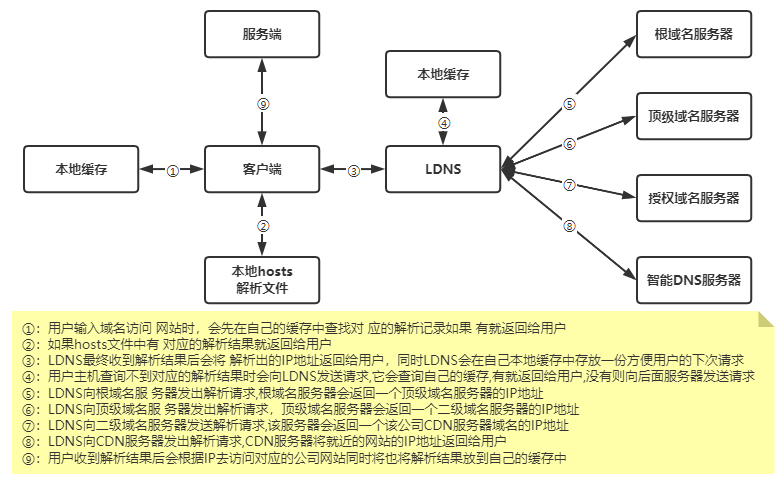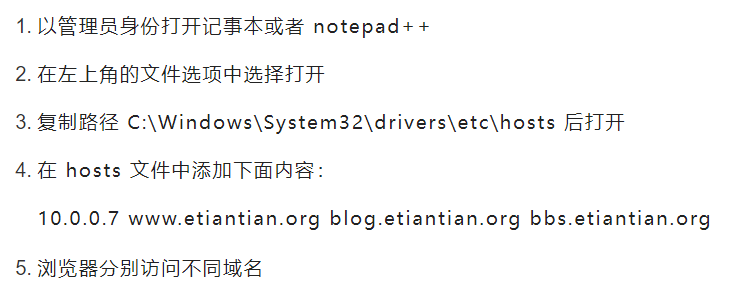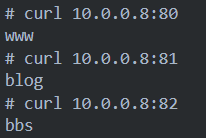【linux运维培训】nginx 虚拟主机介绍与配置!
![]() 老男孩IT教育
老男孩IT教育
![]() 技术博客
技术博客
![]() 2022年11月23日 14:09
2022年11月23日 14:09
所谓一个虚拟主机,在Web服务里就是一个独立的网站站点,这个站点对应独立的域名(也可能是IP或端口),具有独立的程序及资源目录,可以独立地对外提供服务供用户访问。
- Nginx 虚拟主机的介绍
- Nginx 客户端访问流程
- Nginx 虚拟主机的部署
- Nginx 虚拟主机多实例
- Nginx 常用模块的介绍
什么是虚拟主机
虚拟主机概念:所谓一个虚拟主机,在Web服务里就是一个独立的网站站点,这个站点对应独立的域名(也可能是IP或端口),具有独立的程序及资源目录,可以独立地对外提供服务供用户访问
一台服务器里,或者一个nginx里怎么能提供这么多域名服务呢?
首页
一套集群 www.jd.com
二级页:
一套集群 diannao.jd.comchannel.jd.com
内容页:
一套集群 https://item.jd.com/50760357152.html
订单页:
一套支付页集群
一套物流跟踪集群
一套评价页面集群
apache虚拟主机包含在 内,而Nginx软件则使用一个 server{}标签来标示一个虚拟主机

为什么要用虚拟主机
1、一个nginx主进程,指定一个配置文件,配置文件里有多个虚拟主机。
2、如果不用虚拟主机,一个diannao.jd.com就要对应一个服务器,浪费
3、多实例:多个nginx主进程,每个nginx进程,指定不同的配置文件(目录、代码、域名也不同)
虚拟机主机分类
1)基于【域名】的虚拟主机
以不同的多个域名区分不同的虚拟主机,放在一个nginx服务上,还能够让用户有序访问 生产用途:企业提供正常网站服务
2)基于【端口】的虚拟主机
以不同的端口,来区分多个虚拟主机,肯定也是放在一个nginx服务上,还能够让用户有序访问
生产用途:
不对外提供访问的服务,网站的后台,测试环境
各种应用,API接口(10.0.0.7:8091)
所有网站也用特殊端口,前端有负载均衡(80),负载均衡下面的节点是什么端口无所谓
好的思路:后台单独用开启web服务器
不做域名解析
不用80端口
不配公网IP
VPN拨号,内网访问
客户端访问流程

基于域名的虚拟主机配置
| 系统环境

| 配置主配置文件
# cd /application/nginx/conf
# cat nginx.conf
worker_processes 1;
events {
worker_connections 1024;
}
http {
include mime.types;
default_type application/octet-stream;
sendfile on;
keepalive_timeout 65;
include /application/nginx/conf/extra/*.conf;
}
| 配置虚拟主机路径及配置文件
第一个配置文件
# mkdir /application/nginx/conf/extra/
# vim /application/nginx/conf/extra/01_www.etiantian.org.conf
server {
listen 80;
server_name www.etiantian.org;
location / {
root html/www;
index index.html index.htm;
}
}
第二个配置文件
# vim /application/nginx/conf/extra/02_blog.etiantian.org.conf
server {
listen 80;
server_name blog.etiantian.org;
location / {
root html/blog;
index index.html index.htm;
}
}
第三个配置文件
# vim /application/nginx/conf/extra/03_bbs.etiantian.org.conf
server {
listen 80;
server_name bbs.etiantian.org;
location / {
root html/bbs;
index index.html index.htm;
}
}
| 创建虚拟主机站点目录
# cd /application/nginx/html
# mkdir www blog bbs
# echo "www" >www/index.html
# echo "blog" >blog/index.html
# echo "bbs" >bbs/index.html
| 检查语法重启服务
nginx -t
nginx -s reload
| 配置Linux hosts并访问
# tail -1 /etc/hosts
10.0.0.7 www.etiantian.org blog.etiantian.org bbs.etiantian.org
| 配置windows hosts并访问

基于端口的虚拟主机配置
| 配置虚拟主机
# vim /application/nginx/conf/extra/01_www.etiantian.org.conf
server {
listen 80;
server_name www.etiantian.org;
location / {
root html/www;
index index.html index.htm;
}
}
# vim /application/nginx/conf/extra/02_blog.etiantian.org.conf
server {
listen 81;
server_name blog.etiantian.org;
location / {
root html/blog;
index index.html index.htm;
}
}
# vim /application/nginx/conf/extra/03_bbs.etiantian.org.conf
server {
listen 82;
server_name bbs.etiantian.org;
location / {
root html/bbs;
index index.html index.htm;
}
}
| 检查语法并重启
nginx -t
nginx -s reload
| 通过IP地址加端口访问网站

基于【IP】的虚拟主机配置
| 配置多个IP
ifconfig eth0:9 10.0.0.9/24 up
ifconfig eth0:10 10.0.0.10/24 up
ip addr add 10.0.0.11/24 dev eth0 lable eth0:11
| 配置虚拟主机文件
# vim /application/nginx/conf/extra/01_www.etiantian.org.conf
server {
listen 10.0.0.9:80;
server_name 10.0.0.9;
location / {
root html/www;
index index.html index.htm;
}
}
# vim /application/nginx/conf/extra/02_blog.etiantian.org.conf
server {
listen 10.0.0.10:80;
server_name 10.0.0.10;
location / {
root html/blog;
index index.html index.htm;
}
}
# vim /application/nginx/conf/extra/03_bbs.etiantian.org.conf
server {
listen 10.0.0.11:80;
server_name 10.0.0.11;
location / {
root html/bbs;
index index.html index.htm;
}
}
| 检查语法并重启
nginx -t
pkill nginx
nginx
| 通过辅助IP访问nginx

nginx多实例部署
| 添加两个普通用户并设置密码
useradd blog
useradd bbs
echo 123456|passwd --stdin blog
echo 123456|passwd --stdin bbs
| 在不同的用户家目录下面创建各种目录
# cd /home/blog/
# mkdir conf/extra log html -p
# tree
├── conf #主配置文件目录
│ └── extra #虚拟主机目录
├── html #bbs站点目录
└── logs #日志目录
或者直接拷贝
# cp -a /application/nginx/{conf,logs,html} /home/blog
# cp -a /application/nginx/{conf,logs,html} /home/bbs
| bl
利用普通用户权限将不同业务进行彻底分离管理
1)配置nginx配置文件
# ls -ld /home/zuma
drwx------ 5 blog blog 114 7月 15 16:29 /home/blog
# su - zuma
$ tree
.
├── conf
│ ├── extra
│ │ └── 01_www.etiantian.org.conf
│ └── nginx.conf
├── html
│ ├── 50x.html
│ └── index.html
└── logs
├── access.log
├── error.log
└── nginx.pid
主配置(注意路径)
$ cat /home/blog/conf/nginx.conf
user blog;
worker_processes 1;
events {
worker_connections 1024;
}
error_log /home/blog/logs/error.log warn;
pid /home/blog/logs/nginx.pid;
http {
include mime.types;
default_type application/octet-stream;
sendfile on;
keepalive_timeout 65;
log_format main '$remote_addr - $remote_user [$time_local] "$request" '
'$status $body_bytes_sent "$http_referer" '
'"$http_user_agent" "$http_x_forwarded_for"';
include /home/blog/conf/extra/*.conf;
}
#虚拟主机配置(注意路径)
$ vim /home/blog/conf/extra/01_www.etiantian.org.conf
server {
listen 8081;
server_name www.etiantian.org;
location / {
root /home/blog/html;
index index.html index.htm;
}
access_log /home/blog/logs/access.log main;
}
$ cat /home/blog/html/index.html
blog
2)检查语法
$ /application/nginx/sbin/nginx -c /home/blog/conf/nginx.conf -t
nginx: [alert] could not open error log file: open() "/application/nginx-1.20.1//logs/error.log" failed (13: Permission denied)
2021/07/15 16:21:10 [warn] 1702#0: the "user" directive makes sense only if the master process runs with super-user privileges, ignored in /home/blog/conf/nginx.conf:1
nginx: the configuration file /home/blog/conf/nginx.conf syntax is ok
nginx: configuration file /home/blog/conf/nginx.conf test is successful
特别提示:[warn] [alert] 并非错误,可以忽略
3)启动并检查
$ /application/nginx/sbin/nginx -c /home/blog/conf/nginx.conf &>/dev/null
$ lsof -i :8081
COMMAND PID USER FD TYPE DEVICE SIZE/OFF NODE NAME
nginx 1705 blog 5u IPv4 27729 0t0 TCP *:tproxy (LISTEN)
nginx 1706 blog 5u IPv4 27729 0t0 TCP *:tproxy (LISTEN)
4)配置/etc/hosts解析,并访问
$ curl www.etiantian.org:8081
blog
由于文章内容篇幅过长,特将文章分开发布,其余内容见文章链接:https://www.oldboyedu.com/blog/4691.html
 老男孩教育专注IT教育10余年,只培养IT技术精英
老男孩教育专注IT教育10余年,只培养IT技术精英 全国免费咨询电话(渠道合作):400-609-2893
全国免费咨询电话(渠道合作):400-609-2893






















